Suzuki GSX-R 1000 Service Manual: DTC “c22” (p1450-h/l): ap sensor circuit
malfunction
Detected condition and possible cause
|
Detected condition |
Possible cause |
| C22 |
Ap sensor voltage is not within the
following range.
0.5 V ≤ Sensor voltage < 4.85 V
| Note
note that atmospheric pressure
varies depending on weather
conditions as well as altitude.
Take that into consideration
when inspecting voltage. |
|
- Clogged vacuum passage with dust.
- Ap sensor circuit open or shorted to ground.
- Ap sensor malfunction.
- Ecm malfunction.
- Ap sensor circuit is open or shorted to vcc or ground
circuit open.
- Ap sensor circuit is shorted to ground or vcc circuit
open.
|
| P1450 |
H |
Sensor voltage is higher than specified
value. |
|
L |
Sensor voltage is lower than specified
value. |
Wiring diagram
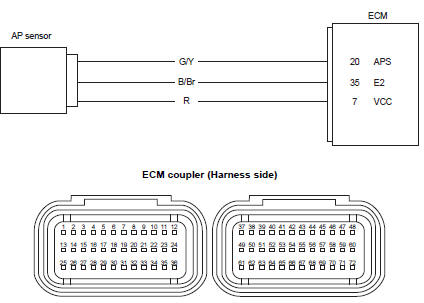
Troubleshooting
| Caution
when using the multi-circuit tester, do not strongly touch the terminal
of the ecm coupler with a
needle pointed tester probe to prevent terminal damage. |
| Note
after repairing the trouble, clear the dtc using sds tool. Refer to “use
of sds diagnosis reset procedures” . |
C22 (use of mode select switch)
|
Step |
Action |
Yes |
No |
|
1 |
- Turn the ignition switch off.
- Remove the front seat. Refer to “exterior parts removal and
installation” in section 9d .
- Remove the starter relay from the bracket.
- Check the ap sensor coupler (1) for loose or poor
contacts.
If ok, then measure the ap sensor input voltage.
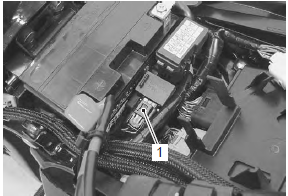
- Disconnect the ap sensor coupler.
- Turn the ignition switch on.
- Measure the input voltage between the r wire and
ground.
If ok, then measure the voltage between the r wire and
b/br wire.
Special tool
 (a): 09900–25008 (multi (a): 09900–25008 (multi
circuit tester set)
Tester knob indication
voltage (  ) )
Ap sensor input voltage
4.5 – 5.5 V
((+) terminal: r – (–) terminal: ground, (+) terminal: r
– (–) terminal: b/br)
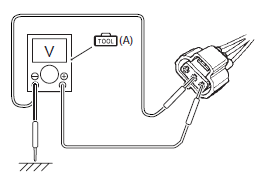
Is the voltage ok? |
Go to step 3. |
- Loose or poor
contacts on the ecm
couplers.
- Open or short circuit
in the r or b/br wire.
|
P1450-h (use of sds)
|
Step |
Action |
Yes |
No |
|
1 |
- Turn the ignition switch off.
- Remove the front seat. Refer to “exterior parts removal and
installation” in section 9d .
- Remove the starter relay from the bracket.
- Check the ap sensor coupler (1) for loose or poor
contacts.
If ok, then check the ap sensor lead wire continuity.
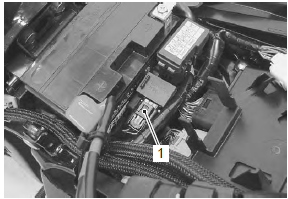
- Disconnect the ap sensor coupler.
- Check the continuity between the r wire and g/y wire.
If the sound is not heard from the tester, the circuit
condition is ok.
Special tool
 (a): 09900–25008 (multi (a): 09900–25008 (multi
circuit tester set)
Tester knob indication
continuity ( ) )
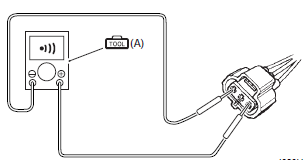
- Disconnect the ecm couplers. Refer to “ecm removal and
installation” in section 1c .
- Insert the needle pointed probes to the lead wire coupler.
- Check the continuity between the g/y wire and terminal
“20”.
If ok, then check the continuity between the b/br wire
and terminal “35”.
Special tool
 (a): 09900–25008 (multi (a): 09900–25008 (multi
circuit tester set)
 (b): 09900–25009 (b): 09900–25009
(needle-point probe set)
Tester knob indication
continuity test ( ) )
Ecm coupler (harness side)
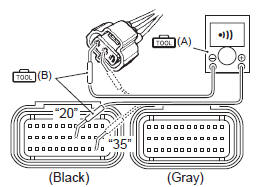
Is the continuity ok? |
Go to step 3. |
G/y wire shorted to
vcc, or b/br wire open. |
P1450-l (use of sds)
|
Step |
Action |
Yes |
No |
|
1 |
- Turn the ignition switch off.
- Remove the front seat. Refer to “exterior parts removal and
installation” in section 9d .
- Remove the starter relay from the bracket.
- Check the ap sensor coupler (1) for loose or poor
contacts.
If ok, then check the ap sensor lead wire continuity.
- Disconnect the ap sensor coupler.
- Check the continuity between the g/y wire and ground.
Also, check the continuity between the g/y wire and b/
br wire. If the sound is not heard from the tester, the
circuit condition is ok.
Special tool
 (a): 09900–25008 (multi (a): 09900–25008 (multi
circuit tester set)
Tester knob indication
continuity ( ) )
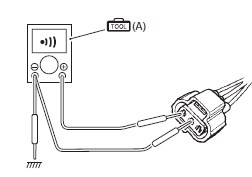
- Disconnect the ecm couplers. Refer to “ecm removal and
installation” in section 1c .
- Insert the needle pointed probes to the lead wire coupler
- Check the continuity between the r wire and terminal
“7”. Also, check the continuity between the g/y wire and
terminal “20”.
Special tool
 (a): 09900–25008 (multi (a): 09900–25008 (multi
circuit tester set)
v(b): 09900–25009 (needle-point probe set)
Tester knob indication
continuity ( ) )
Ecm coupler (harness side)
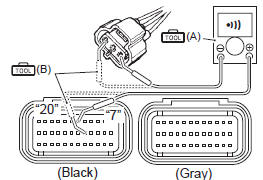
Is the continuity ok? |
Go to step 2. |
R and g/y wire open, g/
y wire shorted to
ground. |
|
2 |
- Connect the ecm couplers.
- Turn the ignition switch on.
- Measure the input voltage between the r wire and
ground.
If ok, then measure the voltage between the r wire and
b/br wire.
Special tool
 (a): 09900–25008 (multi (a): 09900–25008 (multi
circuit tester set)
Tester knob indication
voltage ( ) )
Ap sensor input voltage
4.5 – 5.5 V
((+) terminal: r – (–) terminal: ground, (+) terminal: r
– (–) terminal: b/br)
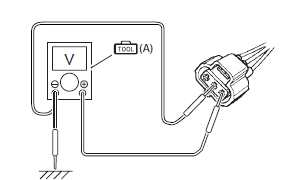
Is the voltage ok? |
Go to step 3. |
- Loose or poor
contacts on the ecm
couplers.
- Open or short circuit
in the r or b/br wire.
|
|
3 |
- Turn the ignition switch off.
- Connect the ecm couplers and ap sensor coupler.
- Insert the needle pointed probes to the lead wire coupler.
- Run the engine at idle speed and measure the ap
sensor output voltage between the g/y wire and b/br
wire.
Special tool
 (a): 09900–25008 (multi (a): 09900–25008 (multi
circuit tester set)
 (b): 09900–25009 (b): 09900–25009
(needle-point probe set)
Tester knob indication
voltage (  ) )
Ap sensor output voltage
approx. 3.6 V at 100 kpa (760 mmhg)
((+) terminal: g/y – (–) terminal: b/br)
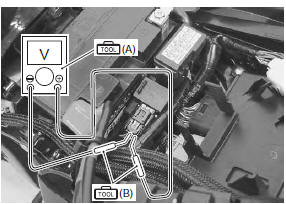
Is the voltage ok? |
Go to step 4. |
- Check the vacuum
port for crack or
damage.
- Open or short circuit
in the g/y wire.
- If vacuum hose and lead wire are ok, replace the ap sensor with
a new one. Refer to “ap sensor removal and installation” in section
1c .
|
|
4 |
- Turn the ignition switch off.
- Remove the ap sensor. Refer to “ap sensor removal and
installation” in section 1c .
- Connect the vacuum pump gauge to the vacuum port of
the ap sensor.
- Arrange 3 new 1.5 V batteries in series (1) (check that
total voltage is 4.5 – 5.0 V) and connect (–) terminal to
the ground terminal “b” and (+) terminal to the vcc
terminal “a”.
- Check the voltage between vout terminal “c” and
ground. Also, check if voltage reduces when vacuum is
applied up to 53 kpa (400 mmhg) by using vacuum
pump gauge.
Special tool
 (a): 09917–47011 (vacuum (a): 09917–47011 (vacuum
pump gauge set)
 (b): 09900–25008 (multi (b): 09900–25008 (multi
circuit tester set)
Tester knob indication
voltage (  ) )
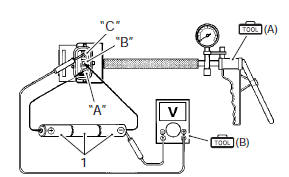

Is the voltage ok? |
- G/y, r or b/br wire
open or shorted to
ground, or poor “7”,
“20” or “35”
connection.
- If wire and
connection are ok,
intermittent trouble or
faulty ecm.
- Recheck each
terminal and wire
harness for open
circuit and poor
connection.
- Replace the ecm with a known good one, and inspect it again.
Refer to “ecm removal and installation” in section 1c .
|
If check result is not satisfactory, replace the ap sensor with a
new one. Refer to “ap sensor removal and installation” in section 1c . |
Detected condition and possible cause
Detected condition
Possible cause
C21
Output voltage is not with in the following
range.
0.15 V ≤ Sensor voltage < ...
Detected condition and possible cause
Detected condition
Possible cause
C23
The sensor voltage should be the
following for 2 sec. And more, after ignition
switch i ...
Other materials:
Rear brake light switch inspection and adjustment
Check the rear brake light switch so that the brake light
will come on just before pressure is felt when the brake
pedal is depressed. If the brake light switch adjustment
is necessary, turn the adjuster nut (1) in or out while
holding the brake pedal.
Brake fluid level check
Refer to “bra ...
Balancer shaft journal bearing removal and
installation
Refer to “engine bottom side disassembly” (page 1d-
49).
Refer to “engine bottom side assembly” .
Removal
Remove the balancer shaft journal bearings (1).
Note
do not remove the bearings (1) unless
absolutely necessary.
Make a note of where the bearings are
r ...
Voltage check
If voltage is supplied to the circuit being checked, voltage
check can be used as circuit check.
With all connectors/couplers connected and voltage
applied to the circuit being checked, measure
voltage between each terminal and body ground.
If measurements were taken as shown ...

 DTC “c21” (p0110-h/l): iat sensor circuit
malfunction
DTC “c21” (p0110-h/l): iat sensor circuit
malfunction DTC “c23” (p1651-h/l): to sensor circuit
malfunction
DTC “c23” (p1651-h/l): to sensor circuit
malfunction

 (a): 09900–25008 (multi
(a): 09900–25008 (multi
 )
)

 (a): 09900–25008 (multi
(a): 09900–25008 (multi
 )
)
 )
)
 (a): 09900–25008 (multi
(a): 09900–25008 (multi
 )
)

 )
)


